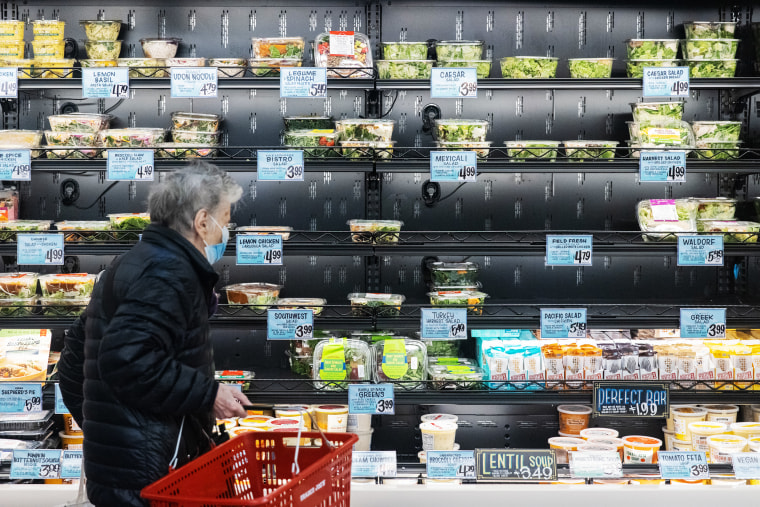Looking back at a turbulent 2021, economists and analysts hit on a few themes that defined the economic trajectory of the past year — and which they say will shape the contours of money, markets and management going into the new year.
The year began with the promise of an end to the coronavirus pandemic with the approval of highly effective vaccines and U.S. consumers ready to spend. It ended with the cloud of the pandemic still hanging over the U.S. economy, as successive variants triggered new waves of disease and lockdowns further aggravated roadblocks in the just-in-time global supply chain. The stock market notched record after record and wages were climbing, but a meteoric rise in the cost of living threatened to dampen or even eclipse the good news — and while jobs remain plentiful, an untold number of workers have remained on the sidelines, unwilling or unable to rejoin the labor market.
The year began with the promise of an end to the pandemic with the approval of highly effective vaccines.
“We came into the year with sort of ... this euphoria that we had vaccines,” said Liz Young, the chief investment officer for SoFi, an online finance company. The early expectations were that the government could mobilize a massive immunization rollout and Covid could be relegated to a historical footnote.
“We saw some really positive information from consumer confidence, consumer spending, GDP,” Young said. “There was a lot of optimism about the economy recovering.” But reality — in the form of resistance to the vaccines and politically motivated misinformation campaigns — collided with the early public health ambitions.
With Americans primed to spend but without enough goods or workers available to meet the burgeoning demand, prices started to soar, first for highly specific goods like computer chips and lumber and then for everything.
“Now we’ve got this weird problem of inflation being high and a labor market that’s sort of stuck, and that’s what the rest of the year ended up being about,” Young said.
Brad McMillan, the chief investment officer at the Commonwealth Financial Network, said it remains unclear how and how severely the spread of the omicron variant of the coronavirus will affect or inhibit economic activity, but he asserted that companies are better prepared today to handle future coronavirus curveballs. “Obviously, we had multiple waves this year,” he said.
“Once everything reopened, we learned we can have considerable growth,” he said. “Looking back, we’ve learned that the economy can keep operating ... despite the pandemic.”
Robust demand was the biggest economic success story, but it also came with a darker flip side in the form of higher prices for rent to refrigerators to restaurant meals. Economists, and even monetary policymakers at the Federal Reserve, have had to revisit their expectations for when inflation would cool. It was only in the last two months of the year that Fed Chair Jerome Powell retreated from the stance that such price spikes were “transitory.”
“The two big things for 2021 were inflation and the labor shortage,” said Dan North, a senior economist at Euler Hermes North America. North said U.S. consumers have been reaping the benefits of globalization in the form of low prices for a growing array of imported goods. “Over the past few decades, the U.S. has been exposed to countries where the wage rate was very, very low. That’s what has kept inflation down,” he said.
Covid threw a wrench into the finely tuned machine: The combination of repeated shutdowns across Asia, port bottlenecks and shortages of all kinds of goods and components turned the U.S. advantage into a liability.
“When you add in the supply chain disruptions, that of course exacerbates the situation,” North said. On top of that came a surge in energy prices, which sent inflationary pressures seeping into nearly every remaining crevice of business and industry.
From an investment standpoint, it was a pretty perfect year.
Lackluster improvement in the labor force participation rate, even as the top-line unemployment number improved more quickly than many had predicted, was another expensive headwind for companies. With record numbers of people quitting their jobs and a multimillion-worker gap between the numbers of available jobs and applicants willing to take them, companies had to raise pay to attract and keep talent. After years of growth below the 3.5 percent to 4 percent rate that economists consider optimal for economic expansion, rapidly rising wages meant U.S. companies were paying more for labor costs on top of rising costs for equipment, materials and other inputs.
And yet, despite a few bouts of volatility, stocks soared in defiance of the looming threat posed by rising inflation. “From an investment standpoint, it was a pretty perfect year,” said Eric Diton, the president and managing director of The Wealth Alliance.
While earnings certainly contributed to the bullish sentiment, technical factors and monetary policy also fueled the big influx of money into Wall Street, Diton said.
“With a big increase in corporate earnings, the Fed’s full-force open market bond buying and keeping rates incredibly low, there was no place to go but stocks. Stocks — and especially U.S. stocks — had a tremendous year as a response,” he said.
Young suggested, however, that the party might be winding down. “The euphoria can only last so long,” she said. “We got to the end of the year and I think reality struck in the sense that as the stock market has been on this runaway tear, the reality of the situation is there are some cracks in the economic pavement.”
The latest inflation projections indicate that higher prices are set to linger through at least the first half of 2022, in a climate of tighter monetary policy rather than the ultra-accommodative stance the Fed adopted in March 2020 and remained committed to until recently, Young said. “We’re not going to be in an environment of unlimited liquidity,” she said. “Valuations matter more.”
